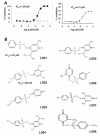Small-molecule inhibitors of acetyltransferase p300 identified by high-throughput screening are potent anticancer agents
- PMID: 23625935
- PMCID: PMC3651759
- DOI: 10.1158/1535-7163.MCT-12-0930
Small-molecule inhibitors of acetyltransferase p300 identified by high-throughput screening are potent anticancer agents
Erratum in
- Mol Cancer Ther. 2013 Aug;12(8):1688. Chase, Peter [added]
Abstract
Acetyltransferase p300 (KAT3B) plays key roles in signaling cascades that support cancer cell survival and sustained proliferation. Thus, p300 represents a potential anticancer therapeutic target. To discover novel anticancer agents that target p300, we conducted a high-throughput screening campaign. A library of 622,079 compounds was assayed for cytotoxicity to the triple-negative breast cancer (TNBC) cell line MDA-MB-231 but not to the human mammary epithelial cells. The resulting compounds were tested in a biochemical assay for inhibiting the enzymatic activity of p300. One compound (L002, NSC764414) displayed an IC50 of 1.98 μmol/L against p300 in vitro, inhibited acetylation of histones and p53, and suppressed STAT3 activation in cell-based assays. L002 could be docked to the active site of the p300 catalytic domain. Biochemical tests of a series of related compounds revealed functional groups that may impact inhibitory potency of L002 against p300. Interestingly, these analogs showed inhibitory activities against the cellular paralog of p300 (CBP), p300/CBP-associated factor, and GCN5, but not to other acetyltransferases (KAT5, KAT6B, and KAT7), histone deacetylases, and histone methyltransferases. Among the NCI-60 panel of cancer cell lines, leukemia and lymphoma cell lines were extremely sensitive to L002, whereas it is toxic to only a limited number of cell lines derived from solid tumors. Notably, breast cancer cell lines, especially those derived from TNBC, were highly susceptible to L002. In vivo, it potently suppressed tumor growth and histone acetylation of MDA-MB-468 xenografts. Thus, these new acetyltransferase inhibitors are potential anticancer therapeutics.
©2013 AACR
Figures






Similar articles
-
Discovery, Structure-Activity Relationship, and Biological Activity of Histone-Competitive Inhibitors of Histone Acetyltransferases P300/CBP.J Med Chem. 2020 May 14;63(9):4716-4731. doi: 10.1021/acs.jmedchem.9b02164. Epub 2020 Apr 21. J Med Chem. 2020. PMID: 32314924 Free PMC article.
-
Discovery of a selective catalytic p300/CBP inhibitor that targets lineage-specific tumours.Nature. 2017 Oct 5;550(7674):128-132. doi: 10.1038/nature24028. Epub 2017 Sep 27. Nature. 2017. PMID: 28953875 Free PMC article.
-
Virtual ligand screening of the p300/CBP histone acetyltransferase: identification of a selective small molecule inhibitor.Chem Biol. 2010 May 28;17(5):471-82. doi: 10.1016/j.chembiol.2010.03.006. Chem Biol. 2010. PMID: 20534345 Free PMC article.
-
The important role of the histone acetyltransferases p300/CBP in cancer and the promising anticancer effects of p300/CBP inhibitors.Cell Biol Toxicol. 2025 Jan 17;41(1):32. doi: 10.1007/s10565-024-09984-0. Cell Biol Toxicol. 2025. PMID: 39825161 Free PMC article. Review.
-
Histone acetyltransferases CBP/p300 in tumorigenesis and CBP/p300 inhibitors as promising novel anticancer agents.Theranostics. 2022 Jun 21;12(11):4935-4948. doi: 10.7150/thno.73223. eCollection 2022. Theranostics. 2022. PMID: 35836809 Free PMC article. Review.
Cited by
-
Exploitation of EP300 and CREBBP Lysine Acetyltransferases by Cancer.Cold Spring Harb Perspect Med. 2017 Mar 1;7(3):a026534. doi: 10.1101/cshperspect.a026534. Cold Spring Harb Perspect Med. 2017. PMID: 27881443 Free PMC article. Review.
-
Inhibition of the HIF1α-p300 interaction by quinone- and indandione-mediated ejection of structural Zn(II).Eur J Med Chem. 2015 Apr 13;94:509-16. doi: 10.1016/j.ejmech.2014.06.006. Epub 2014 Jun 27. Eur J Med Chem. 2015. PMID: 25023609 Free PMC article.
-
Repurposing Tranexamic Acid as an Anticancer Agent.Front Pharmacol. 2022 Jan 13;12:792600. doi: 10.3389/fphar.2021.792600. eCollection 2021. Front Pharmacol. 2022. PMID: 35095503 Free PMC article.
-
Bromodomain proteins as potential therapeutic targets for B-cell non-Hodgkin lymphoma.Cell Biosci. 2024 Nov 23;14(1):143. doi: 10.1186/s13578-024-01326-1. Cell Biosci. 2024. PMID: 39580422 Free PMC article. Review.
-
Discovery, Structure-Activity Relationship, and Biological Activity of Histone-Competitive Inhibitors of Histone Acetyltransferases P300/CBP.J Med Chem. 2020 May 14;63(9):4716-4731. doi: 10.1021/acs.jmedchem.9b02164. Epub 2020 Apr 21. J Med Chem. 2020. PMID: 32314924 Free PMC article.
References
-
- Eckner R, Ewen ME, Newsome D, Gerdes M, DeCaprio JA, Lawrence JB, et al. Molecular cloning and functional analysis of the adenovirus E1A-associated 300-kD protein (p300) reveals a protein with properties of a transcriptional adaptor. Genes Dev. 1994;8:869–84. - PubMed
-
- Gu W, Roeder RG. Activation of p53 sequence-specific DNA binding by acetylation of the p53 C-terminal domain. Cell. 1997;90:595–606. - PubMed
Publication types
MeSH terms
Substances
Grants and funding
LinkOut - more resources
Full Text Sources
Other Literature Sources
Research Materials
Miscellaneous

